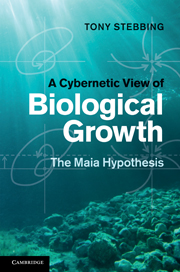Book contents
- Frontmatter
- Contents
- Foreword by Ernest Naylor
- Preface: ‘A fragment of a possible world’
- Acknowledgements
- 1 Introduction
- 2 Growth unlimited: blooms, swarms and plagues
- 3 Self-regulating systems: from machines to humans
- 4 The wealth of homeodynamic responses
- 5 A cybernetic approach to growth analysis
- 6 A control mechanism for Maia
- 7 The three levels of adaptation
- 8 Population growth and its control
- 9 Hierarchy: a controlled harmony
- 10 History of hormesis and links to homeopathy
- 11 Maian mechanisms for hormesis and catch-up growth
- 12 Cellular growth control and cancer
- 13 Human overpopulation
- 14 Our finite Earth
- 15 The Maia hypothesis and anagenesis
- Glossary
- Further reading
- References
- Index
5 - A cybernetic approach to growth analysis
Published online by Cambridge University Press: 10 January 2011
- Frontmatter
- Contents
- Foreword by Ernest Naylor
- Preface: ‘A fragment of a possible world’
- Acknowledgements
- 1 Introduction
- 2 Growth unlimited: blooms, swarms and plagues
- 3 Self-regulating systems: from machines to humans
- 4 The wealth of homeodynamic responses
- 5 A cybernetic approach to growth analysis
- 6 A control mechanism for Maia
- 7 The three levels of adaptation
- 8 Population growth and its control
- 9 Hierarchy: a controlled harmony
- 10 History of hormesis and links to homeopathy
- 11 Maian mechanisms for hormesis and catch-up growth
- 12 Cellular growth control and cancer
- 13 Human overpopulation
- 14 Our finite Earth
- 15 The Maia hypothesis and anagenesis
- Glossary
- Further reading
- References
- Index
Summary
The inanimate have no goals – the living have invisible goals. Not only can they not be seen, but they are not perceived by the vast majority of observers.
Each living being, no matter how simple, has a set of innate goals embedded in it, thanks to the feedback loops that evolved over time, and that characterise its species.
Douglas HofstadterThe tendency to increase in size is, in a sense, the most fundamental feature of living things.
J.Z. YoungTHE GROWTH OF COUNT MONTBEILLARD'S SON
Parents often record the growth of their children by marking increases in height on a door or wall. So it was for Count Philibert Guéneau de Montbeillard, who during the period 1759–1777 measured the height of his son at regular intervals over the first 18 years of his life. The Count's measurements show a steady increase in height (Figure 5.1) throughout these years. The curves showing increase in size (W) over time (t) represent the traditional way that growth is depicted, and the attainment of a respectable size is what matters to a doting parent. Sadly the Count's son ended his life prematurely on the guillotine at the behest of Robespierre.
For the student of the physiology of growth, the cumulative growth curve is uninformative, revealing little about growth as a process (Figure 5.1). The curve hardly changes in slope, so shows little obvious change in rate. Much more informative is the curve showing changes in growth rate over time (Figure 5.1).
- Type
- Chapter
- Information
- A Cybernetic View of Biological GrowthThe Maia Hypothesis, pp. 93 - 115Publisher: Cambridge University PressPrint publication year: 2010



